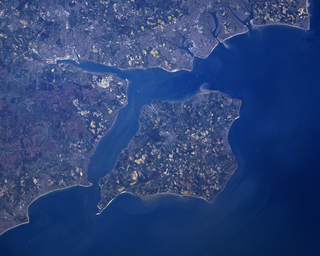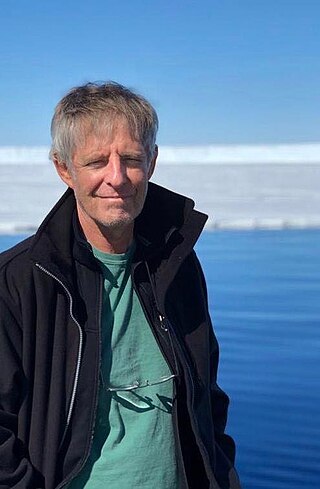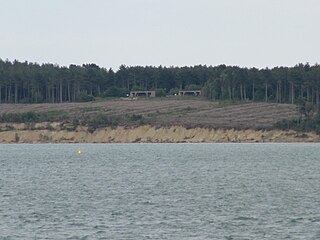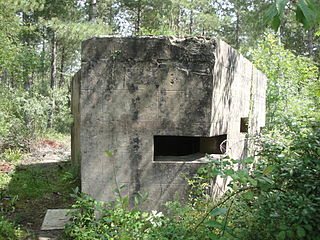
Maritime archaeology is a discipline within archaeology as a whole that specifically studies human interaction with the sea, lakes and rivers through the study of associated physical remains, be they vessels, shore-side facilities, port-related structures, cargoes, human remains and submerged landscapes. A specialty within maritime archaeology is nautical archaeology, which studies ship construction and use.

The Solent is a strait between the Isle of Wight and mainland Great Britain; the major historic ports of Southampton and Portsmouth lie inland of its shores. It is about 20 miles long and varies in width between 2+1⁄2 and 5 mi, although the Hurst Spit which projects 1+1⁄2 mi (2.4 km) into the Solent narrows the sea crossing between Hurst Castle and Colwell Bay to just over 1 mi (1.6 km).

Underwater archaeology is archaeology practiced underwater. As with all other branches of archaeology, it evolved from its roots in pre-history and in the classical era to include sites from the historical and industrial eras.

The Needles are a row of three stacks of chalk that rise about 30 metres (98 ft) out of the sea off the western extremity of the Isle of Wight in the English Channel, United Kingdom, close to Alum Bay and Scratchell's Bay, and part of Totland, the westernmost civil parish of the Isle of Wight. The Needles Lighthouse stands at the outer, western end of the formation. Built in 1859, it has been automated since 1994. The waters and adjoining seabed form part of the Needles Marine Conservation Zone and the Needles along with the shore and heath above are part of the Headon Warren and West High Down Site of Special Scientific Interest.

Invincible was originally a 74-gun ship of the line of the French Navy launched in October 1744. Captured on 14 May 1747, she was taken into Royal Navy service as the third rate HMS Invincible. She was wrecked in 1758 after hitting a sandbank. The wreck is a Protected Wreck managed by Historic England.

Treasure hunting is the physical search for treasure. For example, treasure hunters try to find sunken shipwrecks and retrieve artifacts with market value. This industry is generally fueled by the market for antiquities.

HMS Pomone was a 38-gun Leda-class fifth rate of the Royal Navy launched in 1805. She saw action during the Napoleonic Wars, primarily in the Mediterranean while under the command of Captain Robert Barrie. She was wrecked off The Needles, part of the Isle of Wight, in 1811. The wreck is a Protected Wreck managed by Historic England.
Franck Goddio is a French underwater archaeologist who, in 2000, discovered the city of Thonis-Heracleion 7 km (4.3 mi) off the Egyptian shore in Aboukir Bay. He led the excavation of the submerged site of Canopus and of the ancient harbour of Alexandria, including Antirhodos Island. He has also excavated ships in the waters of the Philippines, significantly the Spanish galleon San Diego.

Mensun Bound is a British maritime archaeologist born in Stanley, Falkland Islands. He is best known as director of exploration for two expeditions to the Weddell Sea which led to the rediscovery of the Endurance, in which Sir Ernest Shackleton and a crew of 27 men sailed for the Antarctic on the 1914–1917 Imperial Trans-Antarctic Expedition. The ship sank after being crushed by the ice on 21 November 1915. It was rediscovered by the Endurance22 expedition on 5 March 2022.

Bouldnor is a hamlet near Yarmouth on the west coast of the Isle of Wight in southern England. It is the location of Bouldnor Battery, a gun battery emplacement.

George Robert Fischer was an American underwater archaeologist, considered the founding father of the field in the National Park Service. A native Californian, he did undergraduate and graduate work at Stanford University, and began his career with the National Park Service in 1959, which included assignments in six parks, the Washington, D.C. Office, and the Southeast Archaeological Center from which he retired in 1988. He began teaching courses in underwater archaeology at Florida State University in 1974 and co-instructed inter-disciplinary courses in scientific diving techniques. After retirement from the NPS his FSU activities were expanded and his assistance helped shape the university's program in underwater archaeology.

Bouldnor Cliff is a submerged prehistoric settlement site in the Solent. The site dates from the Mesolithic era and is in approximately 11 metres of water just offshore of the village of Bouldnor on the Isle of Wight in the United Kingdom. The preservation of organic materials from this era that do not normally survive on dry land has made Bouldnor important to the understanding of Mesolithic Britain, and the BBC Radio 4's Making History programme described it "probably Europe's most important Mesolithic site" albeit concealed under water.

Bouldnor Battery is a military battery located in Bouldnor on the Isle of Wight. It saw active service in World War II and was fully decommissioned in 1956. Today, it is a Scheduled Ancient Monument.
Site Recorder is a geographical information system (GIS) and information management system (IMS) designed for use in maritime, freshwater and intertidal archaeology. Site Recorder can be used on maritime and intertidal archaeology projects for real-time data collection, decision support, publication, archiving and data migration. The program is designed for use by archaeologists rather than GIS experts.

The Underwater Archaeology Branch (UAB) of the Naval History & Heritage Command (NHHC) is a unit of the United States Department of the Navy. It was formally founded in 1996 as a consequence of the emerging need to manage, study, conserve, and curate the U.S. Navy's submerged cultural resources.
Richard James Vincent Larn, OBE is a retired Chief Petty Officer in the Royal Navy, a businessman and maritime history writer who is widely regarded as one of Britain's leading historic shipwreck experts.
The Maritime Archaeology Trust is a charitable trust that researches and excavates maritime archaeology and heritage in Great Britain. Historically, their core activities were focused around Hampshire, the Isle of Wight and the Solent, but now they work in other parts of the country and on international projects.

Back of the Wight is an area on the Isle of Wight in England. The area has a distinct historical and social background, and is geographically isolated by the chalk hills, immediately to the North, as well as poor public transport infrastructure. Primarily agricultural, the Back of the Wight is made up of small villages spread out along the coast, including Brighstone, Shorwell and Mottistone.

Graeme Henderson is an Australian maritime historian and maritime archaeologist. Since the early 1970s he played a leading role in developing maritime archaeology and maritime museums in Australia, having assisted in, or led the investigation of wrecks in the Fremantle area as well as on the Western Australian coast, on islands offshore and in the Eastern States. Henderson was the first Director of the new Western Australian Maritime Museum on Victoria Quay from 1992 to 2005.
R. Helen Farr is a British maritime archaeologist and prehistorian who specialises in prehistoric submerged landscapes and early seafaring. Farr is a certified (HSE) commercial diver. She is lecturer in the Marine and Maritime Institute in the Department of Archaeology at the Southampton University. Farr was elected as a Fellow of the Society of Antiquaries of London on 17 October 2019.
















